Business Strategy Report: An Analysis of Sainsbury's Performance
VerifiedAdded on 2021/02/20
|11
|2664
|76
Report
AI Summary
This report provides a comprehensive analysis of Sainsbury's business strategy. It begins with an introduction defining business strategy and outlining the report's scope. The main body delves into macro-environment factors such as political, economic, social, technological, legal, and environmental influences, specifically examining the impact of Brexit. It then assesses Sainsbury's industry position using Porter's Five Forces model, evaluating competitive rivalry, barriers to entry, threat of substitutes, and the power of buyers and suppliers. The report further explores Sainsbury's internal resources and capabilities through a SWOT analysis, identifying strengths, weaknesses, opportunities, and threats. Finally, it examines the perspectives of key stakeholders, including customers, employees, and shareholders, and their influence on the company's strategies and outcomes. The report concludes with a summary of the key findings and insights into Sainsbury's strategic positioning within the UK retail market.
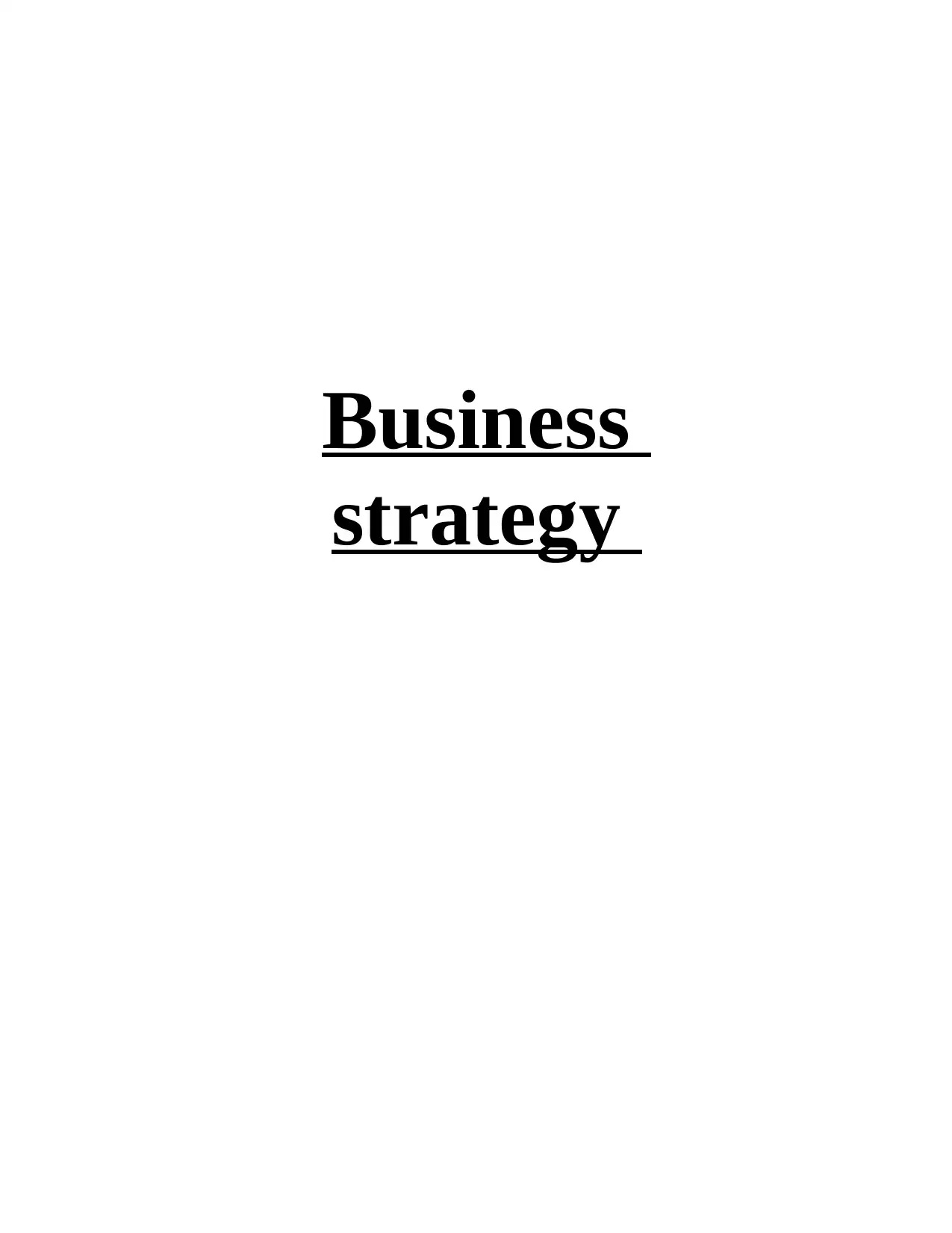
Business
strategy
strategy
Paraphrase This Document
Need a fresh take? Get an instant paraphrase of this document with our AI Paraphraser

Table of Contents
INTRODUCTION...........................................................................................................................1
Main body .......................................................................................................................................1
1. Macro-environment factors :...................................................................................................1
2.industry position:......................................................................................................................2
3. Internal resources and capabilities..........................................................................................4
4. stakeholder perspective...........................................................................................................7
CONCLUSION................................................................................................................................8
REFERENCES................................................................................................................................9
INTRODUCTION...........................................................................................................................1
Main body .......................................................................................................................................1
1. Macro-environment factors :...................................................................................................1
2.industry position:......................................................................................................................2
3. Internal resources and capabilities..........................................................................................4
4. stakeholder perspective...........................................................................................................7
CONCLUSION................................................................................................................................8
REFERENCES................................................................................................................................9

INTRODUCTION
Business strategy is defined as a long term plan which is designed to achieve set goals
and objective of an organisation. Sainsbury is chosen as the base company in this present report.
It is the third largest chain of supermarket in United Kingdom founded by John James Sainsbury
in 1869. This report includes micro-environment factors and industry position. At last, internal
resources and capabilities and perspectives of stakeholder will be examined (Baker, 2012).
Main body
1. Macro-environment factors :
Macro environment factors are defined as external and uncontrollable factors which
affect the organisation decision making, strategy and performance. These macro-environment
factors include political, economic, social, technological, legal and environment factors. These
factors are explained below:
Political factor: The political factors are defined as the government policies which
affect the organization’s performance. Political factors include tax policies, fiscal policies, trade
tariffs etc. Political factor has great impact on the performance of Sainsbury. Brexit sparked off a
cascade effect on the performance of Sainsbury in many different ways. In this context, Brexit
has negative impact on performance of Sainsbury which include high inflation, sluggish
economy which resulted in declines in consumer spending. This policy of Brexit increased
import taxes and rise in prices. However, the firm has effective political presence within other
countries as well and with effective political integration, there are several opportunities for
expansion available for the firm overseas (Buller, 2012).
Economic factors: This economic factors include growth, inflation rate, interest rate,
exchange rate and employment rate that have direct and indirect impact on organisation
Currently, due to the market conditions of the UK and reduction in value of pound, the firm is
suffering from quite a loss. However, with various skilled individual out of work due ot closing
of MNC's the firm has opportunity to allow them to work with the company.
Social factors: This factors includes population, growth rate, age, attitude , health and
cultural barrier of the environment. Nowadays customers prefer convenience in their shopping
and a wide variety of products at one place. Sainsbury has quite a variety of products which has
been an opportunity for the company socially. However, due to heavy competitiom, there is a
1
Business strategy is defined as a long term plan which is designed to achieve set goals
and objective of an organisation. Sainsbury is chosen as the base company in this present report.
It is the third largest chain of supermarket in United Kingdom founded by John James Sainsbury
in 1869. This report includes micro-environment factors and industry position. At last, internal
resources and capabilities and perspectives of stakeholder will be examined (Baker, 2012).
Main body
1. Macro-environment factors :
Macro environment factors are defined as external and uncontrollable factors which
affect the organisation decision making, strategy and performance. These macro-environment
factors include political, economic, social, technological, legal and environment factors. These
factors are explained below:
Political factor: The political factors are defined as the government policies which
affect the organization’s performance. Political factors include tax policies, fiscal policies, trade
tariffs etc. Political factor has great impact on the performance of Sainsbury. Brexit sparked off a
cascade effect on the performance of Sainsbury in many different ways. In this context, Brexit
has negative impact on performance of Sainsbury which include high inflation, sluggish
economy which resulted in declines in consumer spending. This policy of Brexit increased
import taxes and rise in prices. However, the firm has effective political presence within other
countries as well and with effective political integration, there are several opportunities for
expansion available for the firm overseas (Buller, 2012).
Economic factors: This economic factors include growth, inflation rate, interest rate,
exchange rate and employment rate that have direct and indirect impact on organisation
Currently, due to the market conditions of the UK and reduction in value of pound, the firm is
suffering from quite a loss. However, with various skilled individual out of work due ot closing
of MNC's the firm has opportunity to allow them to work with the company.
Social factors: This factors includes population, growth rate, age, attitude , health and
cultural barrier of the environment. Nowadays customers prefer convenience in their shopping
and a wide variety of products at one place. Sainsbury has quite a variety of products which has
been an opportunity for the company socially. However, due to heavy competitiom, there is a
1
⊘ This is a preview!⊘
Do you want full access?
Subscribe today to unlock all pages.

Trusted by 1+ million students worldwide
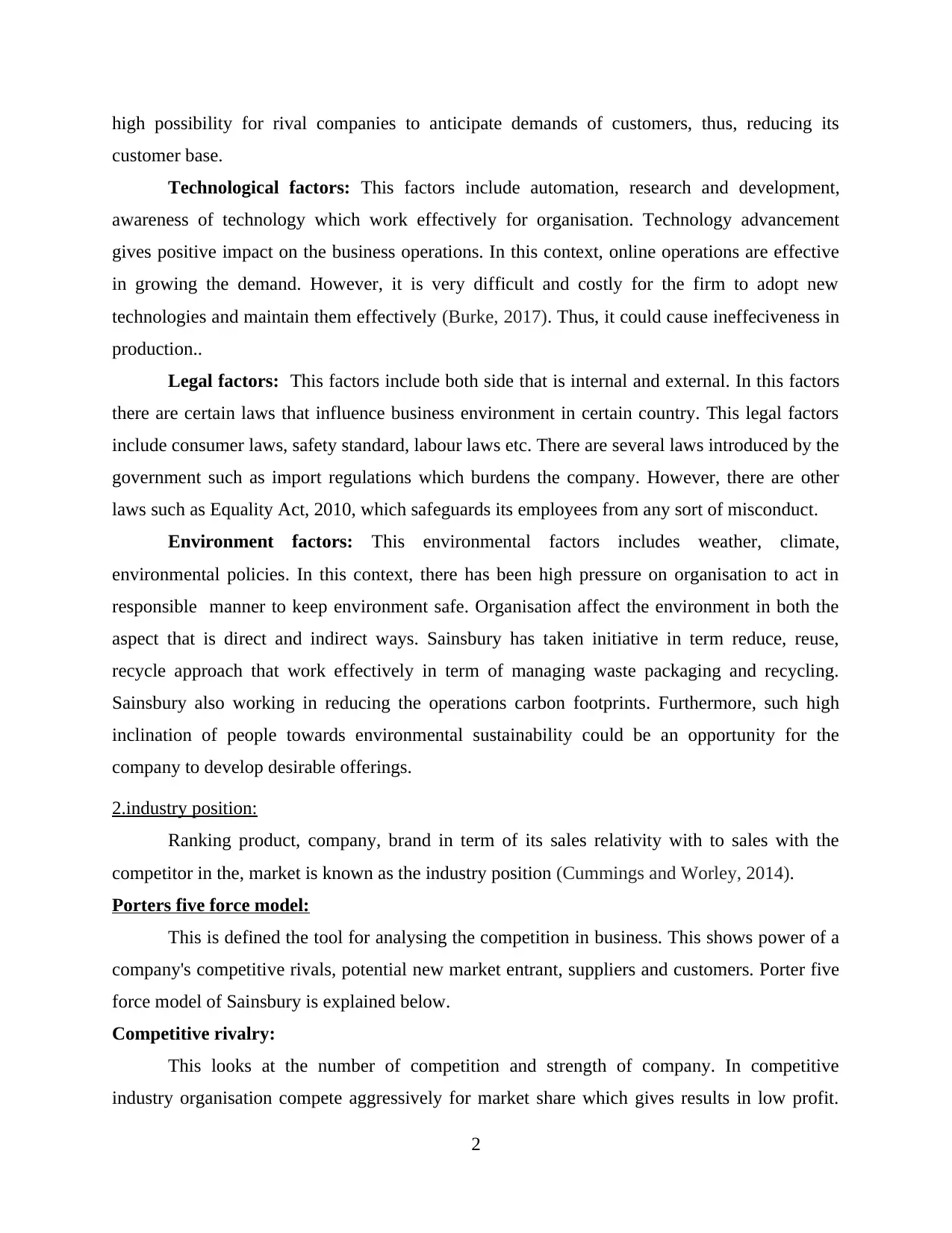
high possibility for rival companies to anticipate demands of customers, thus, reducing its
customer base.
Technological factors: This factors include automation, research and development,
awareness of technology which work effectively for organisation. Technology advancement
gives positive impact on the business operations. In this context, online operations are effective
in growing the demand. However, it is very difficult and costly for the firm to adopt new
technologies and maintain them effectively (Burke, 2017). Thus, it could cause ineffeciveness in
production..
Legal factors: This factors include both side that is internal and external. In this factors
there are certain laws that influence business environment in certain country. This legal factors
include consumer laws, safety standard, labour laws etc. There are several laws introduced by the
government such as import regulations which burdens the company. However, there are other
laws such as Equality Act, 2010, which safeguards its employees from any sort of misconduct.
Environment factors: This environmental factors includes weather, climate,
environmental policies. In this context, there has been high pressure on organisation to act in
responsible manner to keep environment safe. Organisation affect the environment in both the
aspect that is direct and indirect ways. Sainsbury has taken initiative in term reduce, reuse,
recycle approach that work effectively in term of managing waste packaging and recycling.
Sainsbury also working in reducing the operations carbon footprints. Furthermore, such high
inclination of people towards environmental sustainability could be an opportunity for the
company to develop desirable offerings.
2.industry position:
Ranking product, company, brand in term of its sales relativity with to sales with the
competitor in the, market is known as the industry position (Cummings and Worley, 2014).
Porters five force model:
This is defined the tool for analysing the competition in business. This shows power of a
company's competitive rivals, potential new market entrant, suppliers and customers. Porter five
force model of Sainsbury is explained below.
Competitive rivalry:
This looks at the number of competition and strength of company. In competitive
industry organisation compete aggressively for market share which gives results in low profit.
2
customer base.
Technological factors: This factors include automation, research and development,
awareness of technology which work effectively for organisation. Technology advancement
gives positive impact on the business operations. In this context, online operations are effective
in growing the demand. However, it is very difficult and costly for the firm to adopt new
technologies and maintain them effectively (Burke, 2017). Thus, it could cause ineffeciveness in
production..
Legal factors: This factors include both side that is internal and external. In this factors
there are certain laws that influence business environment in certain country. This legal factors
include consumer laws, safety standard, labour laws etc. There are several laws introduced by the
government such as import regulations which burdens the company. However, there are other
laws such as Equality Act, 2010, which safeguards its employees from any sort of misconduct.
Environment factors: This environmental factors includes weather, climate,
environmental policies. In this context, there has been high pressure on organisation to act in
responsible manner to keep environment safe. Organisation affect the environment in both the
aspect that is direct and indirect ways. Sainsbury has taken initiative in term reduce, reuse,
recycle approach that work effectively in term of managing waste packaging and recycling.
Sainsbury also working in reducing the operations carbon footprints. Furthermore, such high
inclination of people towards environmental sustainability could be an opportunity for the
company to develop desirable offerings.
2.industry position:
Ranking product, company, brand in term of its sales relativity with to sales with the
competitor in the, market is known as the industry position (Cummings and Worley, 2014).
Porters five force model:
This is defined the tool for analysing the competition in business. This shows power of a
company's competitive rivals, potential new market entrant, suppliers and customers. Porter five
force model of Sainsbury is explained below.
Competitive rivalry:
This looks at the number of competition and strength of company. In competitive
industry organisation compete aggressively for market share which gives results in low profit.
2
Paraphrase This Document
Need a fresh take? Get an instant paraphrase of this document with our AI Paraphraser
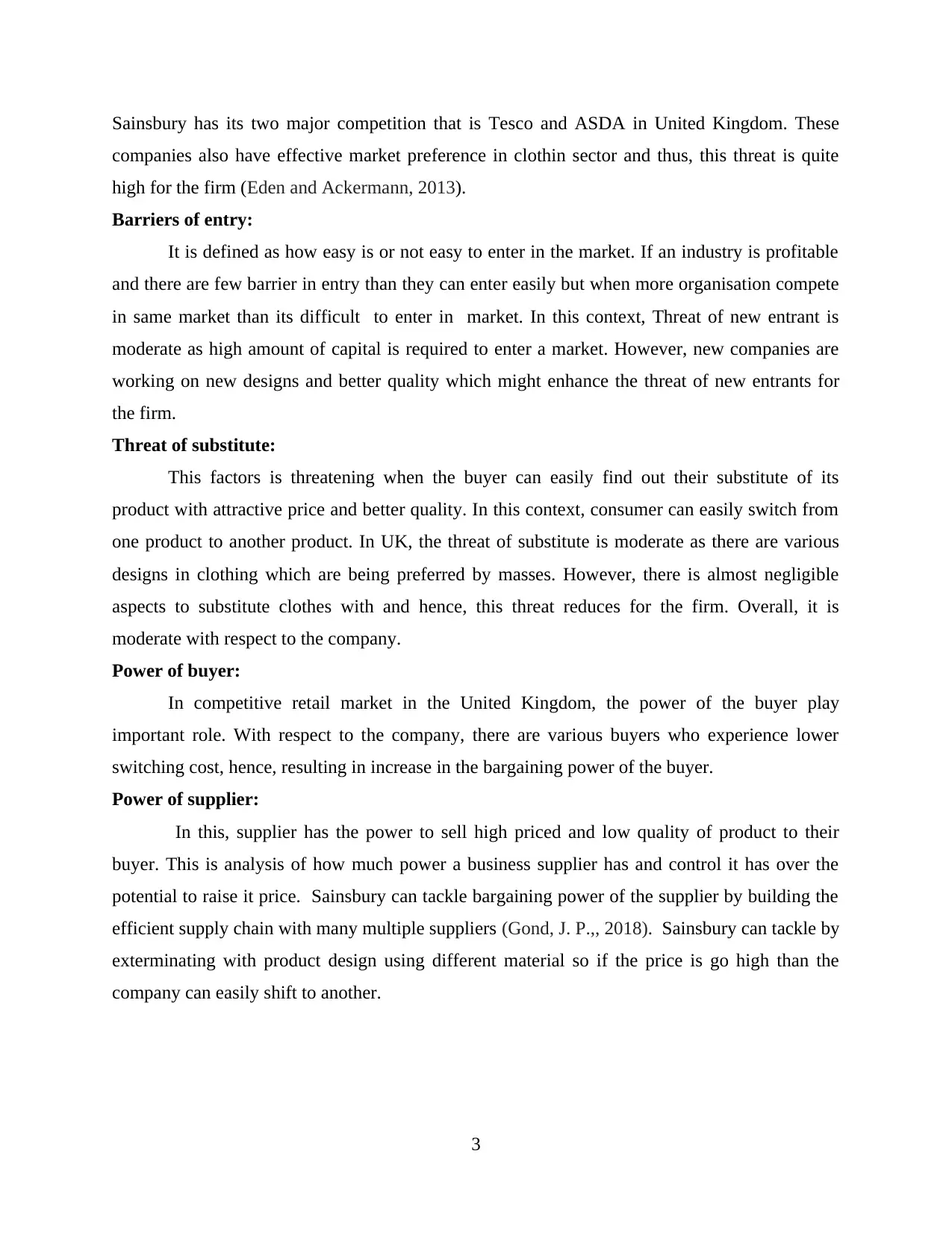
Sainsbury has its two major competition that is Tesco and ASDA in United Kingdom. These
companies also have effective market preference in clothin sector and thus, this threat is quite
high for the firm (Eden and Ackermann, 2013).
Barriers of entry:
It is defined as how easy is or not easy to enter in the market. If an industry is profitable
and there are few barrier in entry than they can enter easily but when more organisation compete
in same market than its difficult to enter in market. In this context, Threat of new entrant is
moderate as high amount of capital is required to enter a market. However, new companies are
working on new designs and better quality which might enhance the threat of new entrants for
the firm.
Threat of substitute:
This factors is threatening when the buyer can easily find out their substitute of its
product with attractive price and better quality. In this context, consumer can easily switch from
one product to another product. In UK, the threat of substitute is moderate as there are various
designs in clothing which are being preferred by masses. However, there is almost negligible
aspects to substitute clothes with and hence, this threat reduces for the firm. Overall, it is
moderate with respect to the company.
Power of buyer:
In competitive retail market in the United Kingdom, the power of the buyer play
important role. With respect to the company, there are various buyers who experience lower
switching cost, hence, resulting in increase in the bargaining power of the buyer.
Power of supplier:
In this, supplier has the power to sell high priced and low quality of product to their
buyer. This is analysis of how much power a business supplier has and control it has over the
potential to raise it price. Sainsbury can tackle bargaining power of the supplier by building the
efficient supply chain with many multiple suppliers (Gond, J. P.,, 2018). Sainsbury can tackle by
exterminating with product design using different material so if the price is go high than the
company can easily shift to another.
3
companies also have effective market preference in clothin sector and thus, this threat is quite
high for the firm (Eden and Ackermann, 2013).
Barriers of entry:
It is defined as how easy is or not easy to enter in the market. If an industry is profitable
and there are few barrier in entry than they can enter easily but when more organisation compete
in same market than its difficult to enter in market. In this context, Threat of new entrant is
moderate as high amount of capital is required to enter a market. However, new companies are
working on new designs and better quality which might enhance the threat of new entrants for
the firm.
Threat of substitute:
This factors is threatening when the buyer can easily find out their substitute of its
product with attractive price and better quality. In this context, consumer can easily switch from
one product to another product. In UK, the threat of substitute is moderate as there are various
designs in clothing which are being preferred by masses. However, there is almost negligible
aspects to substitute clothes with and hence, this threat reduces for the firm. Overall, it is
moderate with respect to the company.
Power of buyer:
In competitive retail market in the United Kingdom, the power of the buyer play
important role. With respect to the company, there are various buyers who experience lower
switching cost, hence, resulting in increase in the bargaining power of the buyer.
Power of supplier:
In this, supplier has the power to sell high priced and low quality of product to their
buyer. This is analysis of how much power a business supplier has and control it has over the
potential to raise it price. Sainsbury can tackle bargaining power of the supplier by building the
efficient supply chain with many multiple suppliers (Gond, J. P.,, 2018). Sainsbury can tackle by
exterminating with product design using different material so if the price is go high than the
company can easily shift to another.
3
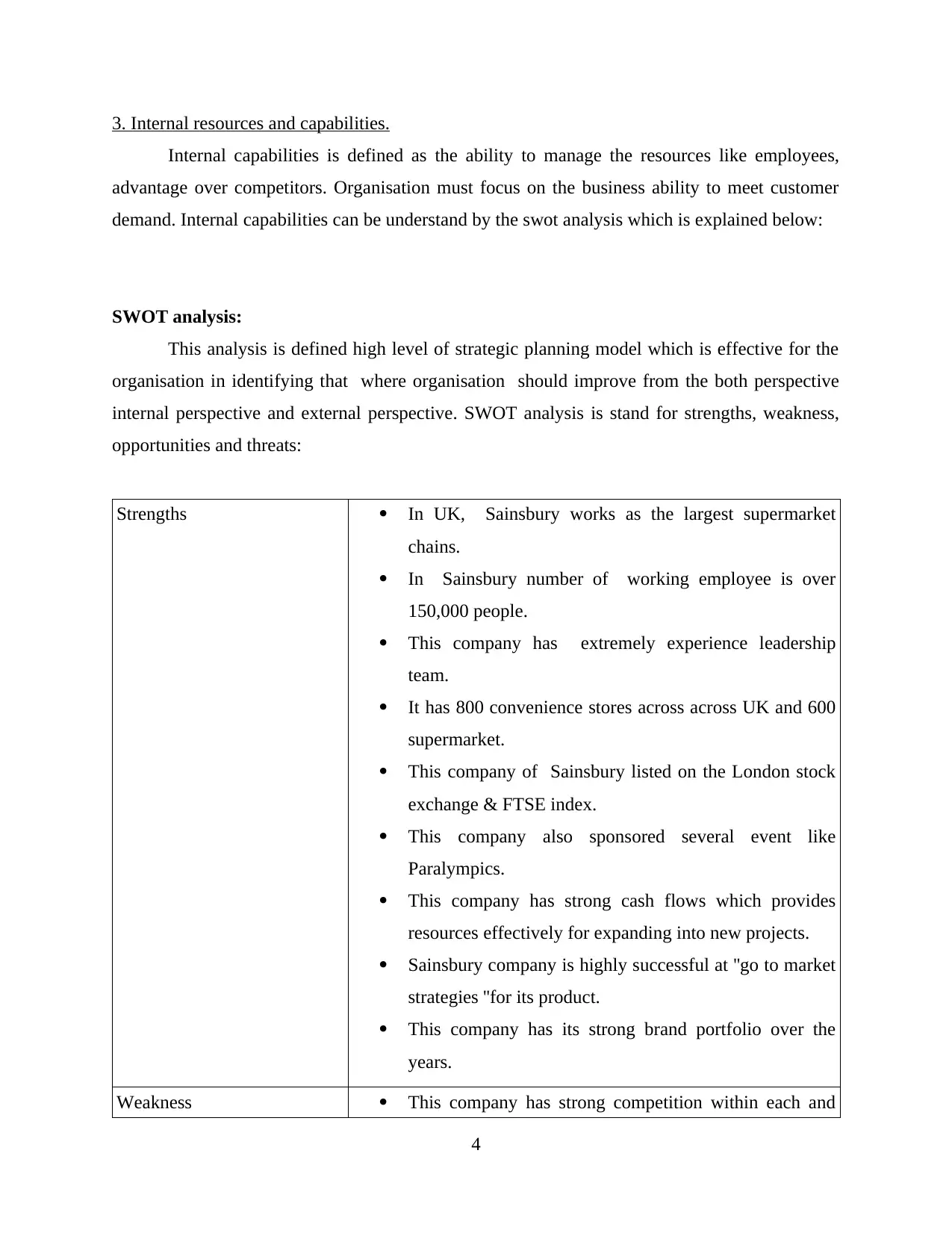
3. Internal resources and capabilities.
Internal capabilities is defined as the ability to manage the resources like employees,
advantage over competitors. Organisation must focus on the business ability to meet customer
demand. Internal capabilities can be understand by the swot analysis which is explained below:
SWOT analysis:
This analysis is defined high level of strategic planning model which is effective for the
organisation in identifying that where organisation should improve from the both perspective
internal perspective and external perspective. SWOT analysis is stand for strengths, weakness,
opportunities and threats:
Strengths In UK, Sainsbury works as the largest supermarket
chains.
In Sainsbury number of working employee is over
150,000 people.
This company has extremely experience leadership
team.
It has 800 convenience stores across across UK and 600
supermarket.
This company of Sainsbury listed on the London stock
exchange & FTSE index.
This company also sponsored several event like
Paralympics.
This company has strong cash flows which provides
resources effectively for expanding into new projects.
Sainsbury company is highly successful at ''go to market
strategies ''for its product.
This company has its strong brand portfolio over the
years.
Weakness This company has strong competition within each and
4
Internal capabilities is defined as the ability to manage the resources like employees,
advantage over competitors. Organisation must focus on the business ability to meet customer
demand. Internal capabilities can be understand by the swot analysis which is explained below:
SWOT analysis:
This analysis is defined high level of strategic planning model which is effective for the
organisation in identifying that where organisation should improve from the both perspective
internal perspective and external perspective. SWOT analysis is stand for strengths, weakness,
opportunities and threats:
Strengths In UK, Sainsbury works as the largest supermarket
chains.
In Sainsbury number of working employee is over
150,000 people.
This company has extremely experience leadership
team.
It has 800 convenience stores across across UK and 600
supermarket.
This company of Sainsbury listed on the London stock
exchange & FTSE index.
This company also sponsored several event like
Paralympics.
This company has strong cash flows which provides
resources effectively for expanding into new projects.
Sainsbury company is highly successful at ''go to market
strategies ''for its product.
This company has its strong brand portfolio over the
years.
Weakness This company has strong competition within each and
4
⊘ This is a preview!⊘
Do you want full access?
Subscribe today to unlock all pages.

Trusted by 1+ million students worldwide
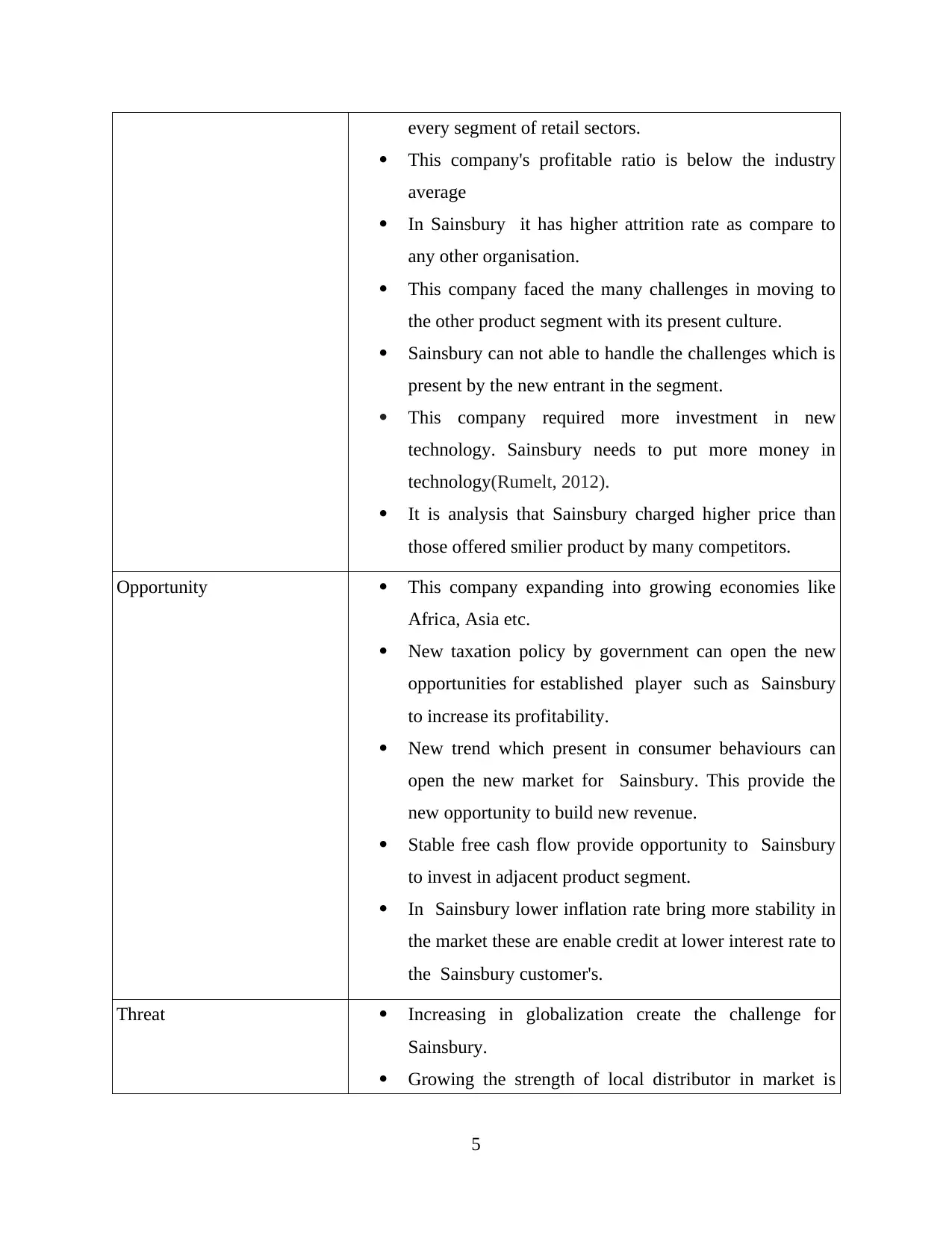
every segment of retail sectors.
This company's profitable ratio is below the industry
average
In Sainsbury it has higher attrition rate as compare to
any other organisation.
This company faced the many challenges in moving to
the other product segment with its present culture.
Sainsbury can not able to handle the challenges which is
present by the new entrant in the segment.
This company required more investment in new
technology. Sainsbury needs to put more money in
technology(Rumelt, 2012).
It is analysis that Sainsbury charged higher price than
those offered smilier product by many competitors.
Opportunity This company expanding into growing economies like
Africa, Asia etc.
New taxation policy by government can open the new
opportunities for established player such as Sainsbury
to increase its profitability.
New trend which present in consumer behaviours can
open the new market for Sainsbury. This provide the
new opportunity to build new revenue.
Stable free cash flow provide opportunity to Sainsbury
to invest in adjacent product segment.
In Sainsbury lower inflation rate bring more stability in
the market these are enable credit at lower interest rate to
the Sainsbury customer's.
Threat Increasing in globalization create the challenge for
Sainsbury.
Growing the strength of local distributor in market is
5
This company's profitable ratio is below the industry
average
In Sainsbury it has higher attrition rate as compare to
any other organisation.
This company faced the many challenges in moving to
the other product segment with its present culture.
Sainsbury can not able to handle the challenges which is
present by the new entrant in the segment.
This company required more investment in new
technology. Sainsbury needs to put more money in
technology(Rumelt, 2012).
It is analysis that Sainsbury charged higher price than
those offered smilier product by many competitors.
Opportunity This company expanding into growing economies like
Africa, Asia etc.
New taxation policy by government can open the new
opportunities for established player such as Sainsbury
to increase its profitability.
New trend which present in consumer behaviours can
open the new market for Sainsbury. This provide the
new opportunity to build new revenue.
Stable free cash flow provide opportunity to Sainsbury
to invest in adjacent product segment.
In Sainsbury lower inflation rate bring more stability in
the market these are enable credit at lower interest rate to
the Sainsbury customer's.
Threat Increasing in globalization create the challenge for
Sainsbury.
Growing the strength of local distributor in market is
5
Paraphrase This Document
Need a fresh take? Get an instant paraphrase of this document with our AI Paraphraser
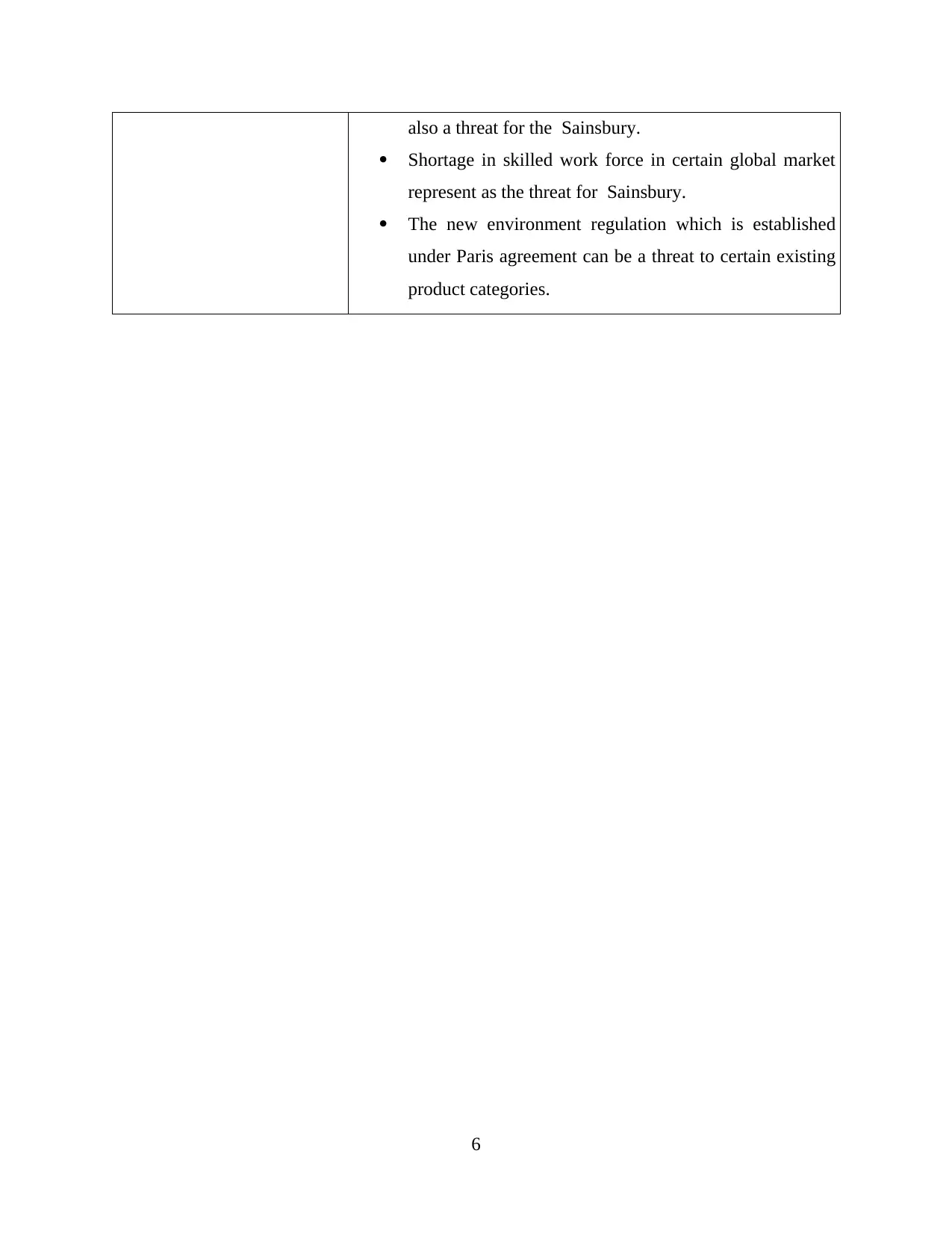
also a threat for the Sainsbury.
Shortage in skilled work force in certain global market
represent as the threat for Sainsbury.
The new environment regulation which is established
under Paris agreement can be a threat to certain existing
product categories.
6
Shortage in skilled work force in certain global market
represent as the threat for Sainsbury.
The new environment regulation which is established
under Paris agreement can be a threat to certain existing
product categories.
6
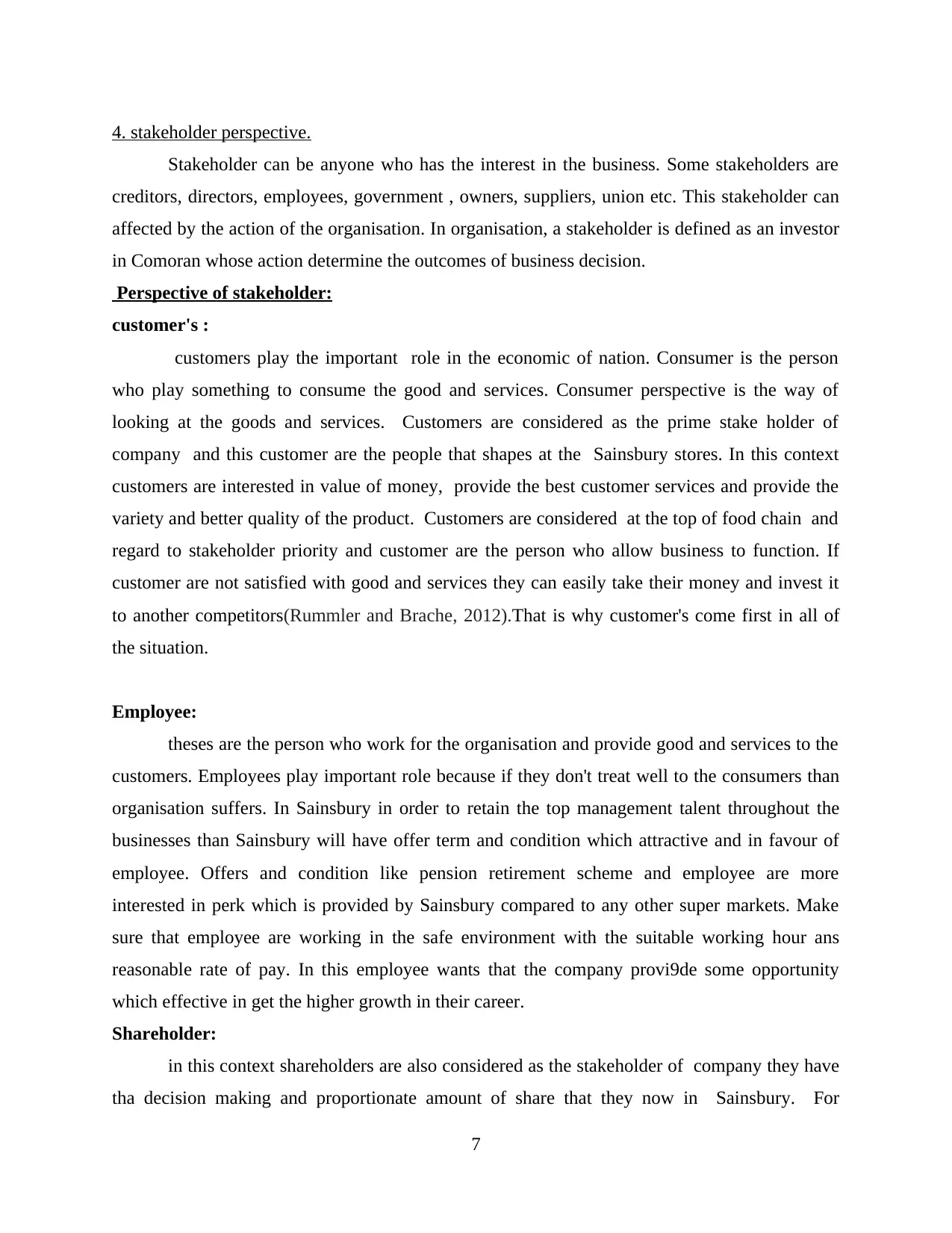
4. stakeholder perspective.
Stakeholder can be anyone who has the interest in the business. Some stakeholders are
creditors, directors, employees, government , owners, suppliers, union etc. This stakeholder can
affected by the action of the organisation. In organisation, a stakeholder is defined as an investor
in Comoran whose action determine the outcomes of business decision.
Perspective of stakeholder:
customer's :
customers play the important role in the economic of nation. Consumer is the person
who play something to consume the good and services. Consumer perspective is the way of
looking at the goods and services. Customers are considered as the prime stake holder of
company and this customer are the people that shapes at the Sainsbury stores. In this context
customers are interested in value of money, provide the best customer services and provide the
variety and better quality of the product. Customers are considered at the top of food chain and
regard to stakeholder priority and customer are the person who allow business to function. If
customer are not satisfied with good and services they can easily take their money and invest it
to another competitors(Rummler and Brache, 2012).That is why customer's come first in all of
the situation.
Employee:
theses are the person who work for the organisation and provide good and services to the
customers. Employees play important role because if they don't treat well to the consumers than
organisation suffers. In Sainsbury in order to retain the top management talent throughout the
businesses than Sainsbury will have offer term and condition which attractive and in favour of
employee. Offers and condition like pension retirement scheme and employee are more
interested in perk which is provided by Sainsbury compared to any other super markets. Make
sure that employee are working in the safe environment with the suitable working hour ans
reasonable rate of pay. In this employee wants that the company provi9de some opportunity
which effective in get the higher growth in their career.
Shareholder:
in this context shareholders are also considered as the stakeholder of company they have
tha decision making and proportionate amount of share that they now in Sainsbury. For
7
Stakeholder can be anyone who has the interest in the business. Some stakeholders are
creditors, directors, employees, government , owners, suppliers, union etc. This stakeholder can
affected by the action of the organisation. In organisation, a stakeholder is defined as an investor
in Comoran whose action determine the outcomes of business decision.
Perspective of stakeholder:
customer's :
customers play the important role in the economic of nation. Consumer is the person
who play something to consume the good and services. Consumer perspective is the way of
looking at the goods and services. Customers are considered as the prime stake holder of
company and this customer are the people that shapes at the Sainsbury stores. In this context
customers are interested in value of money, provide the best customer services and provide the
variety and better quality of the product. Customers are considered at the top of food chain and
regard to stakeholder priority and customer are the person who allow business to function. If
customer are not satisfied with good and services they can easily take their money and invest it
to another competitors(Rummler and Brache, 2012).That is why customer's come first in all of
the situation.
Employee:
theses are the person who work for the organisation and provide good and services to the
customers. Employees play important role because if they don't treat well to the consumers than
organisation suffers. In Sainsbury in order to retain the top management talent throughout the
businesses than Sainsbury will have offer term and condition which attractive and in favour of
employee. Offers and condition like pension retirement scheme and employee are more
interested in perk which is provided by Sainsbury compared to any other super markets. Make
sure that employee are working in the safe environment with the suitable working hour ans
reasonable rate of pay. In this employee wants that the company provi9de some opportunity
which effective in get the higher growth in their career.
Shareholder:
in this context shareholders are also considered as the stakeholder of company they have
tha decision making and proportionate amount of share that they now in Sainsbury. For
7
⊘ This is a preview!⊘
Do you want full access?
Subscribe today to unlock all pages.

Trusted by 1+ million students worldwide

shareholders the activities of Sainsbury will be of great importance to them as shareholder to
keep their level stable. In this context, shareholder perspective they want the sizeable return on
their investment so will almost interested in where their money is going and where that money
is spent. Shareholder have the power to take effective action and decision in the organisation for
example decision like change in management(Varga,. and Whittington,2012).
CONCLUSION
From the above mention report it has been concluded that micro-environment factors can be
understand by the PESTLE model which is effective in understand the different situation in the
organisation. Position of industry set by the ranking system in the market. Industry position can
be understand through the porter five force model. Internal capabilities of organisation can be
understand by the SWOT analysis. In every organisation stakeholder has its different
perspective.
8
keep their level stable. In this context, shareholder perspective they want the sizeable return on
their investment so will almost interested in where their money is going and where that money
is spent. Shareholder have the power to take effective action and decision in the organisation for
example decision like change in management(Varga,. and Whittington,2012).
CONCLUSION
From the above mention report it has been concluded that micro-environment factors can be
understand by the PESTLE model which is effective in understand the different situation in the
organisation. Position of industry set by the ranking system in the market. Industry position can
be understand through the porter five force model. Internal capabilities of organisation can be
understand by the SWOT analysis. In every organisation stakeholder has its different
perspective.
8
Paraphrase This Document
Need a fresh take? Get an instant paraphrase of this document with our AI Paraphraser

REFERENCES
Books and Journals
Baker, J., 2012. The technology–organization–environment framework. In Information systems
theory (pp. 231-245). Springer, New York, NY.
Buller, P. F. and McEvoy, G.M., 2012. Strategy, human resource management and performance:
Sharpening line of sight. Human resource management review, 22(1), pp.43-56.
Burke, W. W., 2017. Organization change: Theory and practice. Sage Publications.
Cummings, T. G. and Worley, C.G., 2014. Organization development and change. Cengage
learning.
Eden, C. and Ackermann, F., 2013. Making strategy: The journey of strategic management.
Sage.
Gond, J. P., and et. el., 2012. Configuring management control systems: Theorizing the
integration of strategy and sustainability. Management Accounting Research.23(3).
pp.205-223.
Hatch, M. J ., 2018. Organization theory: Modern, symbolic, and postmodern perspectives.
Oxford university press.
Rumelt, R. P., 2012. Good strategy/bad strategy: The difference and why it matters. Strategic
Direction. 28(8).
Rummler, G. A. and Brache, A.P., 2012. Improving performance: How to manage the white
space on the organization chart. John Wiley & Sons.
Vaara, E. and Whittington, R., 2012. Strategy-as-practice: Taking social practices seriously. The
Academy of Management Annals. 6(1). pp.285-336.
9
Books and Journals
Baker, J., 2012. The technology–organization–environment framework. In Information systems
theory (pp. 231-245). Springer, New York, NY.
Buller, P. F. and McEvoy, G.M., 2012. Strategy, human resource management and performance:
Sharpening line of sight. Human resource management review, 22(1), pp.43-56.
Burke, W. W., 2017. Organization change: Theory and practice. Sage Publications.
Cummings, T. G. and Worley, C.G., 2014. Organization development and change. Cengage
learning.
Eden, C. and Ackermann, F., 2013. Making strategy: The journey of strategic management.
Sage.
Gond, J. P., and et. el., 2012. Configuring management control systems: Theorizing the
integration of strategy and sustainability. Management Accounting Research.23(3).
pp.205-223.
Hatch, M. J ., 2018. Organization theory: Modern, symbolic, and postmodern perspectives.
Oxford university press.
Rumelt, R. P., 2012. Good strategy/bad strategy: The difference and why it matters. Strategic
Direction. 28(8).
Rummler, G. A. and Brache, A.P., 2012. Improving performance: How to manage the white
space on the organization chart. John Wiley & Sons.
Vaara, E. and Whittington, R., 2012. Strategy-as-practice: Taking social practices seriously. The
Academy of Management Annals. 6(1). pp.285-336.
9
1 out of 11
Related Documents
Your All-in-One AI-Powered Toolkit for Academic Success.
+13062052269
info@desklib.com
Available 24*7 on WhatsApp / Email
![[object Object]](/_next/static/media/star-bottom.7253800d.svg)
Unlock your academic potential
Copyright © 2020–2025 A2Z Services. All Rights Reserved. Developed and managed by ZUCOL.




